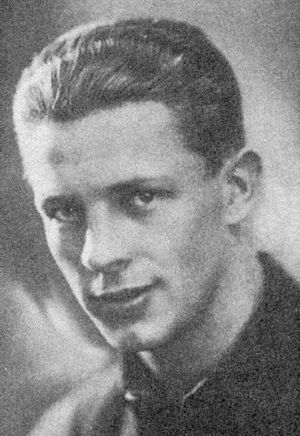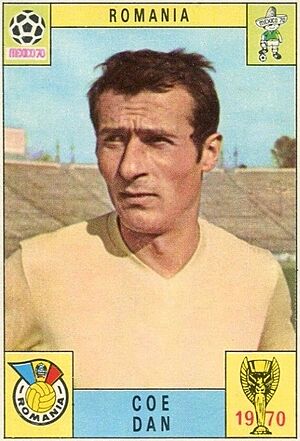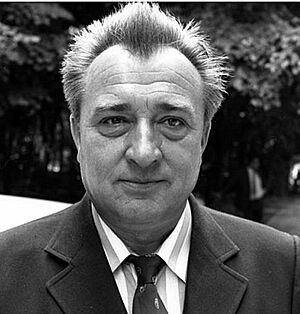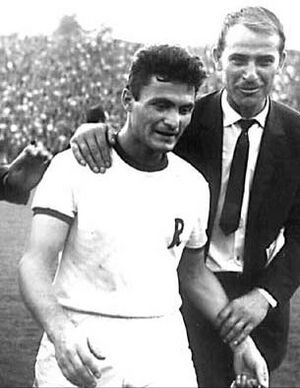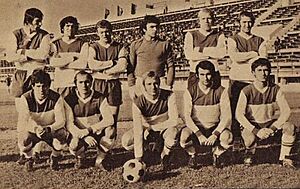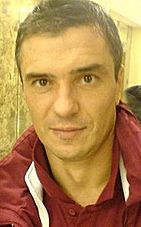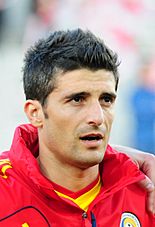History of FC Rapid București facts for kids
The history of Rapid București, a Romanian football club from Bucharest, is a long and exciting one, full of ups and downs. The club was started on June 25, 1923, by workers from the Grivița railway workshops. Rapid is one of Romania's most successful clubs, having won three national league titles, 13 Romanian Cups, and four Romanian Supercups. On the international stage, they reached the quarter-finals of the Cup Winners' Cup in 1973 and the UEFA Cup in 2006. They even made it to the final of the 1940 Mitropa Cup in 1940, but that match wasn't played because of World War II. In 2016, the club faced a tough time and went bankrupt, but it was restarted and managed to return to the top league in 2021.
Contents
How Rapid Started and Its Early Days
Before Rapid, there was an idea for a football club for railway workers called Victoria București in 1912, but World War I stopped it. Then, around 1922, another team called Locomotive was formed. Its cherry-colored shirts were made from tablecloths and curtains from train restaurant cars!
On June 25, 1923, workers from the Grivița workshops officially created the "CFR Cultural and Sports Association" in a school classroom. CFR stands for Căile Ferate Române, which means Romanian Railways. Teofil Copaci became the first president, and Grigore Grigoriu was the first team captain. The team's first uniforms were made from burgundy fabric at Grigoriu's house.
Their first game was on October 28, 1923, against Unirea Timișoara, which they lost 4–8. Ten days later, they lost again to Gloria Arad, 1–2. In 1925, the team was even kicked out of the championship because they couldn't always show up for matches, often due to a lack of equipment or enough players. Until 1932, CFR played in the Bucharest Championship, but they didn't make it to the national league's final tournament.
In 1932, CFR București finally joined the top league, Divizia A. Before World War II, Rapid was one of Romania's best teams. They often won the Romanian Cup but never the championship, though they came very close.
The Golden Years of Rapid
After joining the first division in 1932, Rapid quickly became a top team in Romania. They set a record by winning six Romanian Cups in a row, a feat that still hasn't been broken! They were also the first Romanian team to reach the final of an international cup. This time, along with the team of the 1960s, is considered Rapid's "golden period."
There's a famous story about Rapid losing a league title because of their fair play. In a crucial match against Venus București, a Rapid player accidentally touched the ball with his hand in the penalty area. The referee didn't see it, but when the crowd protested, the player admitted what he did. Venus scored from the penalty kick, and the game ended 1–1, which meant Venus won the league title instead of Rapid. This showed the team's great sportsmanship.
Rapid finished second in the league several times during this period, including in 1932–33, 1936–37, 1939–40, and 1940–41. Their first big success was winning the Romanian Cup in 1935, beating Ripensia Timișoara 6–5 in an amazing final. Gheorghe Georgescu scored three goals in just 15 minutes!
In 1936, the European football authorities decided that teams supported by trade unions (like CFR) couldn't play in the top divisions. So, CFR București had to change its name. A lawyer named Costică Bauer, who had connections in Vienna, helped out. He brought a whole wagon-load of equipment from Rapid Vienna and gave it to CFR. As a thank you, on November 23, 1936, CFR changed its name to Rapid, inspired by the Austrian club.
| Period | Name |
| 1923–1936 | CFR București |
| 1936–1945 | Rapid București |
| 1945–1950 | CFR București |
| 1950–1958 | Locomotiva București |
| 1958–2016 | Rapid București |
| 2016–2017 | Mişcarea Feroviară CFR București |
| 2017–2018 | Academia Rapid București |
| 2018–2019 | Fotbal Club R București |
| 2019–present | Fotbal Club Rapid 1923 |
Rapid won seven Romanian Cups during this time, including six in a row from 1937 to 1942. Key players like Iuliu Baratky, László Raffinsky, and Ion Bogdan were part of these winning teams. This period saw a strong rivalry between CFR and Venus Bucharest. Venus often won the championship, while CFR dominated the Romanian Cup. The 1940 Cup final against Venus was epic, needing three replay matches to decide the winner! Iuliu Baratky scored in all four games.
Rapid also made it to the final of the Mitropa Cup in 1940, which was a very important European competition, a bit like today's UEFA Champions League. They beat teams like Ferencváros and Gradjanski Zagreb to reach the final, but the final match itself was canceled because of World War II.
Rapid Becomes a Strong Team
After World War II, Rapid returned to playing, first in the Bucharest Championship, then back in the national league, Divizia A. They finished 5th in 1947 and 3rd in 1948. In 1949, they came in 2nd, just five points behind the champions. On March 20, 1949, CFR București achieved its biggest victory ever, beating CFR Cluj 12–2!
In the 1950s, the football system changed due to the communist government in Romania. In 1950, Rapid's name was changed to Locomotiva, a name similar to Soviet teams. They finished 2nd that year. However, they were relegated for the first time in 1951. They quickly returned to the top league in 1952, finishing 5th in 1953. They were relegated again in 1954 but came back to Divizia A a year later. In 1956, they finished 4th, only 5 points from the top.
In 1958, Romanian football went back to the old system, and the club returned to its famous name: Rapid. The 1960s were a fantastic time for Rapid. In 1961, they reached the Romanian Cup final but lost to a lower-division team, Arieșul Turda. The next season, in 1962, they made it to the Cup final again but lost to Steaua București 1–5.
Rapid consistently finished in the top half of the league. They were runners-up three years in a row: 1963–64, 1964–65, and 1965–66. These near-misses fueled their determination, and at the end of the 1966–67 season, Rapid achieved its greatest success yet: their first-ever Divizia A title! The team was coached by Valentin Stănescu and included legendary players like Răducanu Necula, Dan Coe, Ion Motroc, Ilie Greavu, Teofil Codreanu, and Ion Ionescu, who was the top scorer with 15 goals. They won the title by two points over Dinamo București.
After this first title, Rapid continued to be strong, often finishing in the top three. In 1968, they reached the Romanian Cup final again but lost to Dinamo.
Challenging Times for Rapid
Rapid had one more strong season in 1970–71, finishing 2nd. After that, they started to drop down the league table. Despite this, in 1972, Rapid won the Romanian Cup again, beating Jiul Petroșani 2–0. In European competitions, they had some good runs, eliminating teams like Napoli and Legia Warsaw in the UEFA Cup before losing to Tottenham Hotspur. In the Cup Winners' Cup, they beat SK Rapid Wien (the team that inspired their name!) but were then knocked out by Leeds United.
At the end of the 1973–74 season, Rapid was surprisingly relegated for the third time, just seven years after winning their first national title. But they bounced back quickly! They were promoted back to the top league after just one year in the second division. Even more amazingly, they won the Romanian Cup in the same season while still a second-division team! Their 1974–75 Cup run was incredible, as they beat strong teams like Dinamo București and Steaua București. In the final, they faced Universitatea Craiova, the league champions, and won 2–1 after extra time, with Nicolae Manea scoring the winning goal.
Back in Divizia A, Rapid had two difficult seasons and were relegated again in 1977, exactly 10 years after becoming champions. This began one of the club's toughest periods, spending six years in the second division. During this time, they developed strong rivalries with Petrolul Ploiești and Progresul București. In a match against Progresul in 1980, over 50,000 fans attended, setting a record for a second-division game! Rapid finally returned to the top league in 1983, thanks to coaches Valentin Stănescu and Viorel Kraus.
A Period of Glory
After returning to the top league, Rapid struggled for a few years. They were relegated again in 1989, their fifth relegation. During this time, they suffered their biggest defeat ever, losing 0–9 to Corvinul Hunedoara in 1985. However, they quickly bounced back, promoting from the second division in 1990.
Back in the top flight, Rapid steadily improved, finishing 11th, then 7th, and then 4th. In 1993, businessman George Copos bought the club, starting what would become one of Rapid's most successful eras. They returned to European competitions after 18 years, playing in the UEFA Cup against teams like Inter Milan and Eintracht Frankfurt.
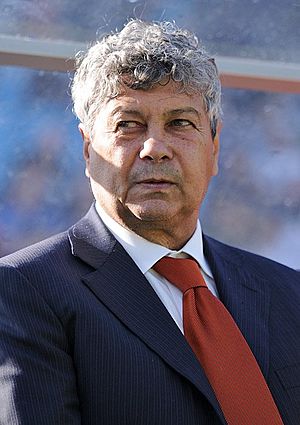
In the 1995–96 season, Rapid finished 3rd, qualifying for the UEFA Cup again. They beat Lokomotiv Sofia but were then eliminated by Karlsruher SC from Germany. The team had a dip in form the next season, finishing 8th.
With Mircea Lucescu as the new coach, Rapid had a fantastic 1997–98 season, finishing 2nd in the league, just two points behind Steaua București. They narrowly missed winning the title. However, they focused on the Romanian Cup and won their 10th title, their first since 1975, by beating Universitatea Craiova 1–0.
The 1998–99 season was truly special. Rapid won the much-desired Romanian championship title, their second in club history, with an impressive 89 points! This great achievement was led by coaches like Mircea Lucescu, Nicolae Manea, and Mircea Rednic, and featured players such as Bogdan Lobonţ, Daniel Pancu, Adrian Iencsi, and Marius Șumudică.
The 1999–2000 season saw Rapid finish 2nd in the league, but they couldn't catch Dinamo București. They also had a disappointing exit from the UEFA Champions League qualifiers. The next few seasons saw changes in coaches and mixed results, but Rapid continued to be a strong team. In 2002, they won their 11th Romanian Cup, beating Dinamo București 2–1, with goals from Marius Măldărășanu and Daniel Pancu.
This strong performance led to another league title! At the end of the 2002–03 season, Rapid won their third national championship, finishing 7 points ahead of Steaua București. The team was coached by Mircea Rednic and included players like Răzvan Raţ, Valentin Bădoi, Florin Bratu, and Daniel Niculae.
After their third title, Rapid had a few seasons where they finished 3rd in the league. In the 2005–06 season, Rapid had their best-ever European run! They started from the first round, qualified for the group stage for the first time, and reached the quarter-finals. They beat teams like Feyenoord, Rennes, Shakhtar Donetsk, PAOK, Hertha BSC, and Hamburger SV. They were only stopped in the quarter-finals by another Romanian team, Steaua București, in a memorable match. Rapid also won the Romanian Cup that season, beating Dinamo București 1–0.
In the next two seasons, Rapid finished 4th and 3rd in the league and won another Romanian Cup in 2007, beating Politehnica Timișoara 2–0. They also continued to play in the UEFA Cup.
Rapid Faces Difficulties
After the 2007–08 season, Rapid started to face financial problems. The team's performance also declined, and they finished in the middle of the league table for several years. However, they showed a burst of pride in the 2010–11 and 2011–12 seasons, finishing 4th twice in a row, which earned them spots in the UEFA Europa League. In 2011–12, they reached the group stage of the Europa League.
In 2013, the Romanian Football Federation decided not to give Rapid a license to play in the top league due to financial issues. The club was then sold to new owners. There was a lot of confusion and legal battles about whether Rapid would stay in the top league, but eventually, they were relegated.
Relegated for the sixth time, Rapid, despite financial struggles, managed to get promoted back to the first league in 2014 under coach Viorel Moldovan. However, they again faced licensing problems. Supporters even donated money to help the club pay a fee to appeal to the Court of Arbitration for Sport, and Rapid was granted a license.
A new owner, Valerii Moraru, bought the club, but the team had a very weak season in 2014–15, finishing 16th and being relegated for the seventh time. Back in the second division, Rapid had a strong season in 2015–16 and won promotion again, despite ongoing financial difficulties. Sadly, the club's historical debts were too much, and on December 14, 2016, FC Rapid București was officially declared bankrupt.
The Rebirth of Rapid
After the bankruptcy, the idea of starting a new Rapid team in the lower leagues emerged. This led to a split among supporters, and two new clubs were formed: AFC Rapid București and Mişcarea Feroviară CFR. Both teams played well and were promoted to the fourth division.
In the summer of 2017, the local government of Sector 1 in Bucharest helped create a new sports association called Academia Rapid București. This club was led by former Rapid players like Daniel Niculae (president), Daniel Pancu (technical director), and Nicolae Stanciu (manager). Supporters saw this new team as the true successor of the original club.
Academia Rapid had an amazing season, winning the Bucharest Liga IV title after a tough fight with Steaua București. They also won the Bucharest Cup and were promoted to the Liga III after winning a play-off match 17–1!
On June 12, 2018, Academia Rapid officially bought the FC Rapid București brand for €406,800. This made them the official successor of the original club, a fact already accepted by most fans.
The 2018–19 season was challenging, but Rapid, now officially FC Rapid București again, still managed to win their league and get promoted to Liga II. On November 24, 2018, Rapid played its last game at the old Giulești Stadium, which was later demolished to build a new, modern stadium.
In the 2019–20 season, Rapid played in the second division. After some coaching changes, including Daniel Pancu and Dan Alexa, assistant coach Mihai Iosif took over. He succeeded where others couldn't, leading Rapid back to the first Romanian League, Liga I! Rapid started the 2021–22 season in Liga I incredibly well, with 5 wins in a row and no goals conceded in their first 7 matches, setting a new record in Romania.
Shirt Sponsors and Manufacturers
| Period | Kit manufacturer | Shirt sponsor |
| 1923–1984 | Unknown | None |
| 1984–1994 | None | |
| 1993–1994 | ||
| 1994–1996 | ||
| 1996–1997 | ||
| 1997–1998 | Overline | |
| 1998–2000 | ||
| 2000–2003 | ||
| 2003–2004 | ||
| 2004–2006 | ||
| 2006–2007 | ||
| 2007–2008 | Holstein | |
| 2008–2009 | ||
| 2009–2010 | ||
| 2010–2011 | ||
| 2011–2012 | ||
| 2012–2013 | None | |
| 2013–2014 | ||
| 2014–2016 | ||
| 2016–2017 | None | None |
| 2017–2018 | ||
| 2019–2021 | ||
| 2021–2023 | ||
| 2023- |
Images for kids


